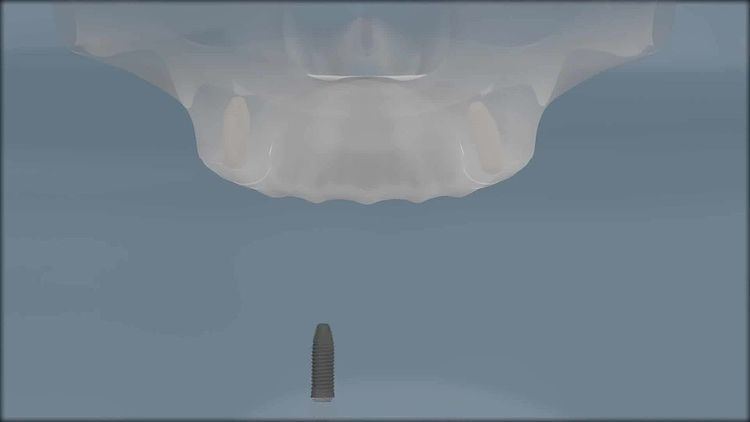 | ||
The term All-On-4 refers to “all” teeth being supported “on four” dental implants, a prosthodontics procedure for total rehabilitation of the edentulous patient or for patients with badly broken down teeth, decayed teeth or compromised teeth due to gum disease. It consists of the rehabilitation of either edentulous or dentate maxilla and/or mandible with fixed prosthesis by placing four implants in the anterior maxilla, where bone density is higher. The four implants support a fixed prosthesis with 10 to 14 teeth and it is placed immediately, typically within 24 hours of surgery.
Contents
- Description of the procedure
- Patent claims for the dental implant fixation
- Price of the treatment
- References
Implant manufacturer Nobel Biocare were among the first to identify the evolution of All-on-4 technique as a potential valid and cost-effective alternative to conventional implant techniques, and funded studies by Portuguese dentist Paulo Maló to determine the efficacy of this approach. During this time this technique was also used by various other clinicians around the world.
All-On-4 is not an invention, but rather a treatment technique that has evolved over time and has the following features:
- four dental implants to support a full fixed bridge (documented since 1977);
- the use of angulated implants in the back to overcome bony deficiencies or anatomical structures (documented since 1990);
- immediate loading (documented since 1990).
The concept itself of the total rehabilitation of a full set of teeth supported by as few as four fixtures was not a new one. Professor P-I Branemark, who discovered osseointegration, published numerous articles in the 1970s with successful rehabilitation of a full arch supported by this number of fixtures. However it was the angulation of the back implants that has led to today’s All-On-4, and has been trialed by numerous clinicians simultaneously in the USA, Sweden, Portugal, and South America in the 1990s. The technique evolved when in an attempt to avoid certain anatomical limitations typically seen in the back of the upper and lower jaws have, clinicians successfully avoided bone-deficient areas with the use of angulated implants. Anatomical limitations are more prevalent in patients with full dentures, and once the back implants are placed at an angle there is often only enough room left for two more implants in the front. This has led to the use of only four fixtures to support a full set of teeth.
Description of the procedure
The All-on-4 treatment concept is a prosthodontic procedure (i.e. replacement of missing teeth) that provides a permanent, screw-retained, same-day replacement for the entire upper and / or lower set of teeth with a bridge or denture. The procedure is best for patients with significant tooth loss or decay and for people whose bone loss in the jaw area prevents them from getting conventionally oriented (vertical) dental implants. Often, tooth loss is accompanied by loss of the jaw bone which poses the problem of reconstruction of the jaw bone requiring bone grafting. The All-On-4 protocol is considered to be a graftless solution thereby avoiding the long and costly road of rebuilding bone when conventionally oriented implants are used. For the implementation to be successful a careful analysis of the bone structure needs to be made. The most ideal way to evaluate the bone is by a CBCT scan. The All-On-4 protocol is for at least 4 implants to be placed in a jaw. The back implants are typically angled approximately 30 to 45 degrees from the biting plane. The implant is placed in front of the maxillary sinus in the upper jaw (maxilla) and in front of the mental nerve in the lower jaw (mandible). The head of the implant emerges in approximately the second premolar position. This will allow a molar tooth to be cantilevered posterior resulting in a denture or bridge with approximately 12 teeth.
The All-on-4 treatment concept owes its name to the very nature of the method, which consists of applying a dental prosthesis with at least twelve teeth (bridge) fixed in the jaw, based only on four titanium implants.
Patent claims for the dental implant fixation
There is no patent for the All-On-4 technique.
Price of the treatment
The price may vary for each country or region, and normally it is divided in two phases. The usual price in the United States is described below:
The total price (if both upper jaw and lower jaw are considered) could possibly reach US$57,000. Clinics with suitable facilities, which are able to offer the entire treatment in the one place, and who do these procedures regularly, are typically the most cost-effective.
In Europe, price for All-on-four is much lower than in the United States.
